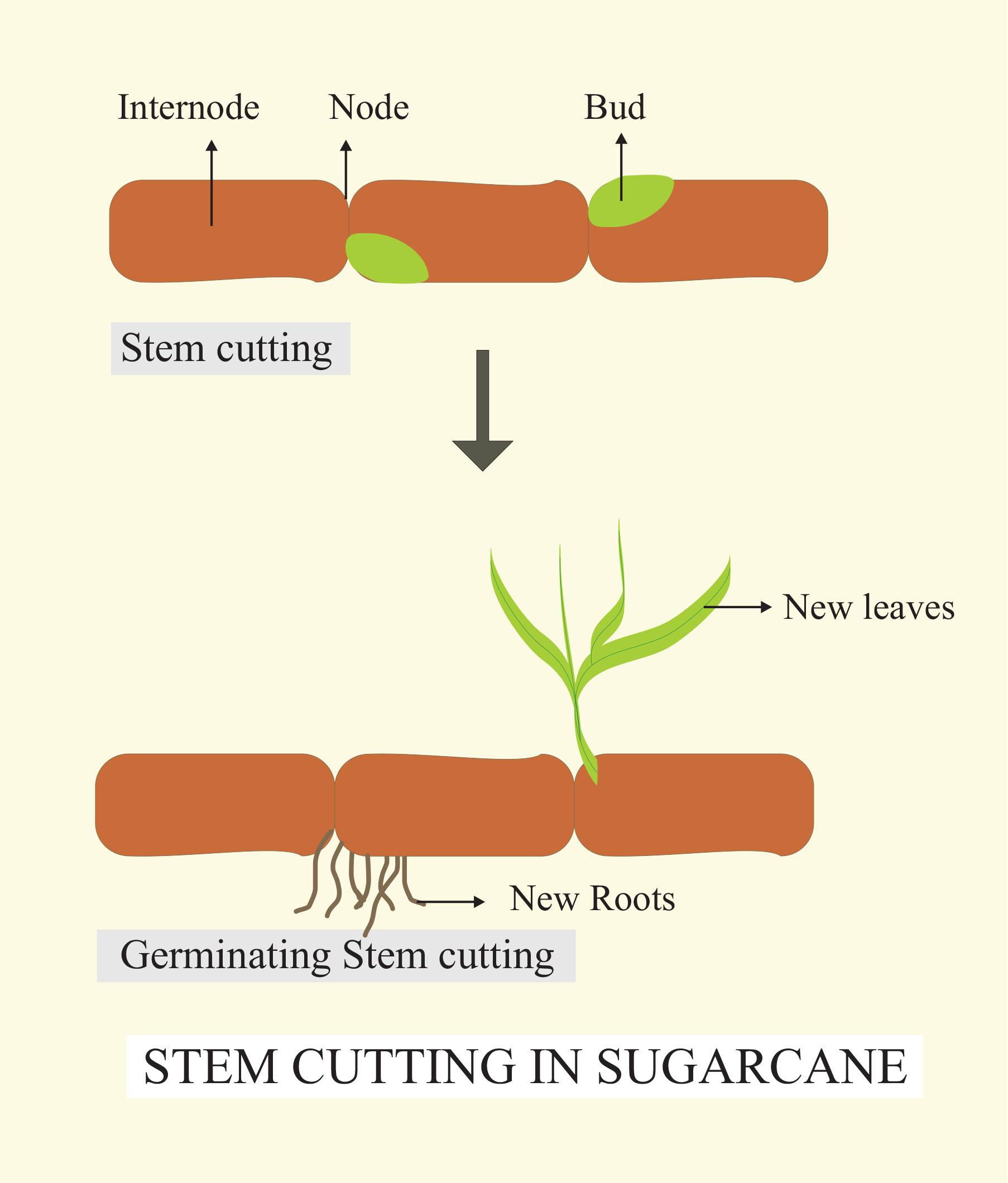
Stem cuttings are commonly used for propagation in
(A)Rubber
(B)Mangoes
(C)Sugarcane
(D)Jasmine
Answer
482.4k+ views
Hint Stem cuttings are commonly used for propagation in that plant which is tall perennial grass in the genus Saccharum, tribe Andropogoneae, that are used for the production of very useful ingredients I.e sugar.
Complete answer: Plant cutting is the common method for vegetative propagation i.e asexual method by which plants are often grown. This method is performed by using stem, roots, or leaf. Stem cutting when placed in soil produces roots and leaves and grows into a brand new plant. The plants that are largely propagated by stem cuttings are Sugar cane, citrus, roses, durant, cocoa, grapes, carnations, bougainvillea, etc.
Additional Information: A stem cutting is a separated portion of plant stem which will regrow into a brand new independent clone via vegetative propagation. There is a range of factors which will influence the successful rooting of a stem cutting, including:
-The Cutting position (whether cutting occurs above or below a node, also because of the relative proximity of the move the node)
-Length of cutting (including what number of nodes remain on the cutting)
-The Growth medium (whether left in the soil, water, potting mix, compost, or open-air)
-The use and concentration of growth hormones.
-The Temperature conditions (most of the plant cuttings grow optimally at temperatures common to spring and summer)
-Availability of water (either within the sort of groundwater or humidity)
-Other environmental conditions (including pH of the soil and lightweight exposure)

So, the correct answer is ‘Sugarcane ’.
Note: All of the stems possess nodes, from which a leaf, branch, or aerial root can grow – the region between nodes are called internodes. Stem cuttings are typically placed in the soil with the lower nodes covered and therefore the upper nodes are exposed.
Complete answer: Plant cutting is the common method for vegetative propagation i.e asexual method by which plants are often grown. This method is performed by using stem, roots, or leaf. Stem cutting when placed in soil produces roots and leaves and grows into a brand new plant. The plants that are largely propagated by stem cuttings are Sugar cane, citrus, roses, durant, cocoa, grapes, carnations, bougainvillea, etc.
Additional Information: A stem cutting is a separated portion of plant stem which will regrow into a brand new independent clone via vegetative propagation. There is a range of factors which will influence the successful rooting of a stem cutting, including:
-The Cutting position (whether cutting occurs above or below a node, also because of the relative proximity of the move the node)
-Length of cutting (including what number of nodes remain on the cutting)
-The Growth medium (whether left in the soil, water, potting mix, compost, or open-air)
-The use and concentration of growth hormones.
-The Temperature conditions (most of the plant cuttings grow optimally at temperatures common to spring and summer)
-Availability of water (either within the sort of groundwater or humidity)
-Other environmental conditions (including pH of the soil and lightweight exposure)

So, the correct answer is ‘Sugarcane ’.
Note: All of the stems possess nodes, from which a leaf, branch, or aerial root can grow – the region between nodes are called internodes. Stem cuttings are typically placed in the soil with the lower nodes covered and therefore the upper nodes are exposed.
Recently Updated Pages
Master Class 12 Business Studies: Engaging Questions & Answers for Success

Master Class 12 English: Engaging Questions & Answers for Success

Master Class 12 Social Science: Engaging Questions & Answers for Success

Master Class 12 Chemistry: Engaging Questions & Answers for Success

Class 12 Question and Answer - Your Ultimate Solutions Guide

Master Class 11 Business Studies: Engaging Questions & Answers for Success

Trending doubts
Draw a labelled sketch of the human eye class 12 physics CBSE

a Tabulate the differences in the characteristics of class 12 chemistry CBSE

Which one of the following is a true fish A Jellyfish class 12 biology CBSE

Why is the cell called the structural and functional class 12 biology CBSE

Differentiate between homogeneous and heterogeneous class 12 chemistry CBSE

Write the difference between solid liquid and gas class 12 chemistry CBSE




